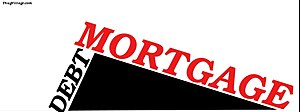 Image via Wikipediamortgage information Home - mortgage information
Image via Wikipediamortgage information Home - mortgage informationMain article: Loan-to-value ratio
Upon making a mortgage loan for the purchase of a property, lenders usually require that the borrower make a downpayment; that is, contribute a portion of the cost of the property. This downpayment may be expressed as a portion of the value of the property (see below for a definition of this term). The loan to value ratio (or LTV) is the size of the loan against the value of the property. Therefore, a mortgage loan in which the purchaser has made a downpayment of 20% has a loan to value ratio of 80%. For loans made against properties that the borrower already owns, the loan to value ratio will be imputed against the estimated value of the property. The loan to value ratio is considered an important indicator of the riskiness of a mortgage loan: the higher the LTV, the higher the risk that the value of the property (in case of foreclosure) will be insufficient to cover the remaining principal of the loan.Value: appraised, estimated, and actual
Since the value of the property is an important factor in understanding the risk of the loan, determining the value is a key factor in mortgage lending. The value may be determined in various ways, but the most common are:- Actual or transaction value: this is usually taken to be the purchase price of the property. If the property is not being purchased at the time of borrowing, this information may not be available.
- Appraised or surveyed value: in most jurisdictions, some form of appraisal of the value by a licensed professional is common. There is often a requirement for the lender to obtain an official appraisal.
- Estimated value: lenders or other parties may use their own internal estimates, particularly in jurisdictions where no official appraisal procedure exists, but also in some other circumstances.


No comments:
Post a Comment